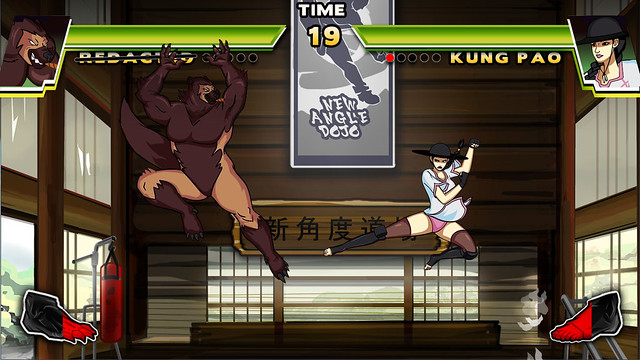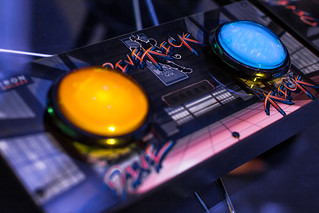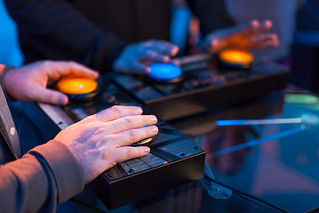
If you follow the fighting game community, you probably already know all about Divekick. If not, take a moment to read this intro post from Iron Galaxy to get up to speed.
Talk of Divekick at GDC last week was impossible to ignore, but how does it actually play? The game’s minimalist design invites skepticism, but rest assured: this is a deeper, more addictive experience that you might imagine. Divekick shrugs off the fighting game genre’s longstanding barriers, creating a sleek, streamlined competitive experience — it’s the primordial essence of what makes fighting games fun.
This is a game about outsmarting and outmaneuvering your opponent. Gone are complex input commands, phalangeal acrobatics, and superhuman timing windows. There are only two buttons: Dive and Kick. You won’t be using the D-pad or analog stick. You can’t block. You can’t even move… at least, not traditionally. To advance towards your opponent you tap Dive (a vertical leap), then Kick to propel your fighter feet-first. A tap of the Kick button while on the ground results an evasive hop backward. Connecting with a single divekick is a one-hit knockout, and the first player to score five knockouts wins. That’s it.
The competitive magic is in the details. For example, when you tap the Kick button is a critical consideration. Close to the ground, where you can recover quickly? Or higher in the air, where you’ll soar further but leave yourself open to counterattack? It’s always worth aiming for your enemy’s noggin to score a dreaded Head Shot, which leaves them dazed and sluggish for the first moments of the next round.
There’s an entire cast of over-the-top characters to choose from, including posterboys Dive and Kick (the palette-swapped Ken and Ryu figures of the game), Dr. Victoria Shoals (reminiscent of Doctor Doom in the Marvel vs Capcom games), Redacted (a cigar-smoking bear that seems vaguely inspired by a certain comic book hero), and many more. Each fighter has a different jump height, kick angle, and divekick speed — it’s not immediately clear whether any of these provide a competitive advantage, but it definitely gives each character a distinctive feel.
But after seeing it and getting past the initial novelty of a two-button, seemingly parodic fighting game, combatants at PlayStation’s GDC Indie Arcade press event got serious. First-to-five went far too fast, and the defeated were quick to queue back up for another shot. At the event, Iron Galaxy set the game up with custom, Divekick-branded fightsticks controllers, though it’s not clear whether those controllers will become available for purchase in the future.
I opted to dole out my divekicks on a standard DualShock 3, hovering my index fingers over the O and X buttons for maximum precision (though L1 and R1 are also supported). I can’t say for sure whether this tactic granted me decreased reaction times, but people seemed to take me more seriously because I was holding the controller funny.
A PS Vita version of the game is on the way as well. One of its unique features is a two-player, one-Vita competitive mode, which Iron Galaxy CEO Dave Lang calls the “most romantic mode in all of fighting games.” One player fights using the Left and Down on the D-pad; the other player uses X and O on the same system — that’s one way to avoid network lag!
Lang assures us that we’ll see plenty more in the final game, including additional characters, a single-player story mode, and full online support. Divekick will land on PSN this summer, for both PS3 and PS Vita. We’ll have more details leading up to launch, so stay tuned. Got any questions about the game? Leave ’em in the comments, and I’ll do my best to get them answered.














Comments are closed.
47 Comments
Loading More Comments